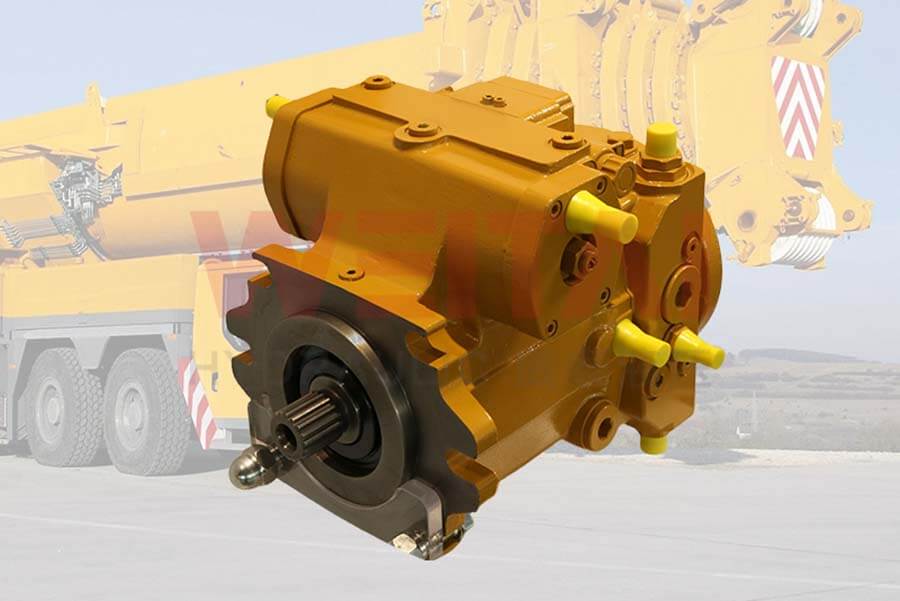The stable and efficient operation of cranes is inseparable from the hydraulic final drive motor. So, where can a hydraulic final drive motor be used in cranes? How does it work in cranes? Today we will discuss these questions.
Hydraulic Final Drive Motor Applications in a Crane
For the travel system, it is the powerhouse that drives the crane to move smoothly on various terrains. Whether it’s on a construction site with uneven ground or a paved road, the hydraulic final drive motor ensures the crane can be quickly and accurately maneuvered to the desired work location. This enables the crane to respond promptly to different job demands and reduces downtime associated with repositioning.
In the lifting mechanism, in some advanced crane designs, hydraulic final drive motors can be integrated into the complex lifting system. They provide the essential power to hoist extremely heavy loads with precision and stability. The motor’s consistent and reliable performance is essential for ensuring the safety of the lifting operation and preventing accidents due to insufficient power or sudden failures.
Regarding the slewing mechanism, the hydraulic final drive motor assists in rotating the crane’s upper structure. This allows the operator to position the crane precisely at different angles, enhancing the flexibility and efficiency of the operation. Whether it’s reaching a specific point for lifting or avoiding obstacles, the slewing mechanism powered by the hydraulic final drive motor is a vital component for seamless crane operations.

How a Hydraulic Final Drive Motor Works in a Crane
The operation of a hydraulic final drive motor in a crane is a complex yet highly efficient mechanical process that enables the crane to perform its various functions.
The Hydraulic Power Supply System
The heart of the operation starts with the crane’s hydraulic power source. A powerful pump, often driven by the crane’s engine, pressurizes the hydraulic fluid. This pump creates a continuous flow of fluid at a specific pressure, which serves as the energy carrier for the final drive motor. The hydraulic fluid, usually a specialized oil with properties that allow for efficient power transmission, is stored in a reservoir until it is needed.
Fluid Flow and Pressure Regulation
When the operator gives a command for the crane to move or perform an action, the control system activates valves that direct the pressurized hydraulic fluid towards the final drive motor. The fluid is routed through a series of hoses and passages with precision. The pressure of the fluid is carefully regulated by a combination of pressure regulators and control valves. These components ensure that the fluid enters the motor at the correct pressure level for the intended operation. If the pressure is too high or too low, it can cause inefficient operation or even damage to the motor and other components.
The Inner Workings of the Motor
The hydraulic final drive motor itself is a marvel of engineering. It commonly contains a rotor and vanes or pistons within a sturdy housing. As the pressurized hydraulic fluid enters the motor chamber, it exerts force on the vanes or pistons. This force causes the rotor to spin. The design of the vanes or pistons allows for smooth and continuous rotation. In some cases, the motor may use a gerotor or other advanced mechanisms to optimize the conversion of hydraulic energy into rotational motion. The housing is designed to withstand the forces generated and to provide proper alignment and support for the moving parts.

Transmitting Power for Crane Movement
The rotational force produced by the motor is then transferred to the relevant parts of the crane. In the travel system, the motor’s rotation is transmitted through gears or shafts to the wheels, enabling the crane to move in different directions. For example, when the crane needs to move forward, the motor rotates in a certain direction, causing the wheels to turn and propel the heavy machine. In the slewing mechanism, the rotational force is used to rotate the upper structure of the crane. This allows the operator to position the crane’s boom accurately for lifting and placing loads. The speed and torque of the motor can be adjusted according to the load requirements and the desired movement speed, ensuring both safety and efficiency during crane operations.
Control and Precision
To achieve precise control, the crane’s hydraulic system employs a variety of control mechanisms. Electronic or hydraulic controls can adjust the flow of the hydraulic fluid to the final drive motor. By changing the flow rate, the speed of the motor can be varied. Additionally, directional control valves determine the direction of the fluid flow, which in turn controls the direction of the motor’s rotation. This allows the operator to make fine adjustments to the crane’s position, such as making small turns or precisely aligning the boom with a load. The overall control system is designed to handle the heavy loads and complex movements that a crane undertakes, providing a reliable and accurate means of operation.
At Last
In a crane, the hydraulic final drive motor plays a crucial role in multiple aspects. It supports the crane to work efficiently and stably. If you need a hydraulic final drive motor for your crane, please contact us. We will do our best to support you.
Post time: Oct-16-2024
